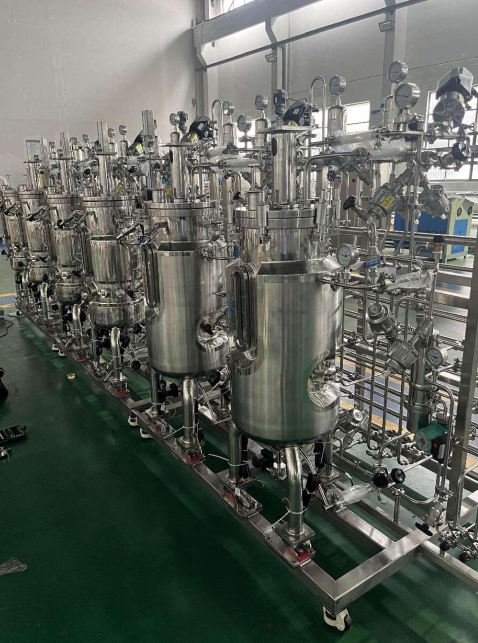
https://www.sinotechmachinery.com/products/parallel-bioreactor/
In the fermentation industry, seed quality is the cornerstone of the production process and is directly related to fermentation efficiency, product yield and quality stability. High-quality seeds are rich in microbial cells with vigorous vitality and stable genetic characteristics, which can quickly adapt to the fermentation environment, efficiently utilize culture medium resources, and promote the rapid accumulation of metabolites. On the contrary, poor seed quality may cause problems such as slow growth and contamination by foreign bacteria, seriously restricting the fermentation process and even leading to production failure. Therefore, strict control of seed preparation technology to ensure high seed purity and strong vitality is the key to improving fermentation production efficiency and ensuring product quality. The main factors affecting seed tank culture include: nutritional conditions, culture conditions, contamination control, determination of expansion level and determination of inoculation amount.
01 Culture medium (nutritional conditions):
The culture medium is related to the acquisition of nutrition and has a direct impact on the growth, reproduction, enzyme activity and yield of microorganisms. The culture medium can be divided into C/N basic growth nutrition, inorganic salt osmotic pressure control, trace element maintenance composition, and pH enzyme activity regulation system.
The requirements for the culture medium are simple composition, abundant sources, low price, and convenient material acquisition. The seed culture medium is the basic environment for seed growth and reproduction. It provides microorganisms with the necessary nutrients, energy sources, and suitable physical and chemical conditions. First of all, sufficient and balanced nutrients are the key to ensuring seed vitality and quantity. For example, carbon source is the energy basis for microbial growth, and nitrogen source is an important component of cell material. If the carbon source or nitrogen source is insufficient, the growth of seeds will be inhibited and the expected quantity and quality cannot be achieved. Inorganic salts in the culture medium, such as phosphorus, sulfur, magnesium, potassium, etc., play an indispensable role in maintaining the osmotic pressure balance of cells, enzyme activity, and structural integrity of cells. Taking phosphorus as an example, it is involved in the synthesis of nucleic acids and phospholipids. If phosphorus is lacking, the replication of cell genetic material and the formation of cell membranes will be hindered, thereby affecting the growth and reproduction of seeds. The purity and impurity content of the culture medium raw materials will affect the growth of microorganisms. If the raw materials contain toxic substances or inhibitors, they may have a toxic effect on the growth of seeds and even cause seed death.
A. The last level of culture medium in the seed tank should be consistent with that in the production tank. At this time, the enzyme system required for fermentation has been established in the previous tank, and it does not need to be rebuilt under the new environmental conditions.
B. The nitrogen source ratio should be increased in the culture medium of the seed tank, and the incremental ratio of inorganic nitrogen should be larger.
C. After the strain is upgraded, due to equipment differences (tank type, stirring form, speed, etc.), the culture medium ratio needs to be readjusted according to the experiment.
02 species age, inoculation amount:
The seed age requirement is of great significance for transplanting in the logarithmic growth phase.
Because the young seeds have not fully grown and matured, various enzyme systems and metabolic mechanisms in the cells have not yet been fully established, resulting in a weak ability to adapt to the new environment after repotting and a slow start-up speed. The old species, on the other hand, may also perform poorly in the new environment due to reasons such as reduced cell viability and metabolic capacity. Both situations will prolong the fermentation cycle, increase production costs, and ultimately lead to lower yields. The inoculation amount has a significant impact on the length of the lag phase in the new environment. When the inoculation amount is large, the accompanying metabolites such as RNA required for cell division and reproduction are abundant. These metabolites can quickly support the growth and reproduction of cells in the new environment, allowing cells to quickly enter the logarithmic growth phase and shorten the time to adapt to the new environment.
On the contrary, if the inoculation amount is too small, the content of metabolites in the cells is insufficient, and the cells need to spend more time to synthesize the required substances, thus prolonging the lag period. Taking the production of alcohol by yeast fermentation as an example, when the inoculation amount is insufficient, the alcohol production rate in the early stage of fermentation will be significantly slowed down, resulting in the entire fermentation cycle being prolonged and production efficiency reduced.
03 Temperature:
Look at the temperature in the early stage and dissolved oxygen in the later stage.
Any microorganism has its optimal growth temperature and production temperature, as follows:
Species | Thermal lethal conditions | Growth temperature/°C |
Temperature/℃ | Time/min | Optimum | limit |
Mold | Mycelium | 60 | 5-10 | 25-30 | 15-37 |
Spore | 65-70 | 5-10 |
Yeast | Nutrition Cells | 55-65 | 2-3 | 20-28 | 10-35 |
Spore | 60 | 10-15 |
Bacteria | Nutrition Cells | 63 | 30 | 35-40 | 5-45 |
Spore | 100 or more |
|
In the field of biology, temperature, as one of the key environmental factors for microbial growth, has a significant impact on the growth rate and metabolic activities of microorganisms. According to a general rule, the growth rate of microorganisms usually doubles for every 10°C increase. This is mainly because temperature can directly affect the metabolic enzyme system in cells.
Enzymes are proteins that catalyze chemical reactions in organisms, and almost all microbial growth and metabolic processes are catalyzed by enzymes. The reaction rate of enzymes is greatly affected by temperature. There is an optimal temperature range. Within this range, the enzyme activity is the highest and the growth and metabolism of microorganisms are also the fastest. When the temperature is lower than the optimal temperature, the activity of the enzyme decreases and the growth rate of microorganisms slows down; when the temperature is higher than the optimal temperature, the enzyme may lose activity due to denaturation, resulting in the growth of microorganisms being hindered or even death.
04 pH effect:
4.1 Effect of pH value on enzyme activity:
Enzyme activity regulation: Enzymes are key proteins that catalyze biochemical reactions in microorganisms, and their activity is significantly affected by pH value. Each enzyme has its optimal pH range, within which the enzyme activity is highest. When the pH value deviates from the optimal range, the enzyme activity will gradually decrease or even become completely inactive. This will cause the metabolic process of microorganisms to be blocked, affecting the absorption and utilization of nutrients, thereby reducing seed quality.
Affecting metabolic pathways: Changes in pH may also cause changes in microbial metabolic pathways. For example, under acidic conditions, certain microorganisms may increase the lactic acid fermentation pathway to maintain pH homeostasis, which may change the types and proportions of metabolites, thereby affecting seed quality.
4.2 Effect of pH value on cell membrane:
Cell membrane permeability: pH value can affect the charge state of the microbial cell membrane, thereby changing the permeability of the cell membrane. The cell membrane is the main channel for microorganisms to exchange substances with the external environment. Changes in its permeability will directly affect the absorption of nutrients and the excretion of metabolites by microorganisms.
Cell stability: Under extreme pH conditions, the structure of the cell membrane may be damaged, causing intracellular substances to leak out or external harmful substances to enter the cell, thereby affecting the normal physiological functions of the cell.
4.3 Effect of pH value on nutrient absorption:
Affects the dissociation of nutrients: Nutrients (such as amino acids, minerals, etc.) in the culture medium dissociate to different degrees under different pH conditions, which will affect the absorption and utilization efficiency of these nutrients by microorganisms.
Competition affecting nutrients: In mixed culture systems, different microorganisms have different abilities to absorb and utilize nutrients. Changes in pH may change this competitive relationship, thereby affecting the growth and reproduction of dominant bacterial species.
Non-optimal pH values will cause the growth rate of microorganisms to slow down or even stagnate, which will affect the biomass accumulation and quality improvement of seeds; long-term cultivation of microorganisms under inappropriate pH conditions may lead to changes in their genetic characteristics (such as genes mutations, gene recombination, etc.), thereby affecting the genetic stability of seeds and the stability of subsequent fermentation production; a suitable pH value can improve the stress resistance of microorganisms (such as antioxidant, resistance to osmotic pressure, etc.), allowing them to better adapt Complex and changeable production environment and maintain stable growth and metabolic status.
Anions (acetate, phosphate) are absorbed or nitrogen sources are utilized to produce NH3, causing the pH to rise;
Cations (NH4+, K+) are absorbed or organic acids accumulate, causing the pH to drop;
The pH of high C culture medium moves to low pH;
The pH of high N medium moves toward high pH.
There are three ways to adjust pH: a acid-base solution; b buffer solution; c physiological buffer (physiological acidic or physiological alkaline salt).
05 Aeration and stirring:
The ventilation volume, tank pressure, and stirring jointly determine the current dissolved oxygen state. Only when the dissolved oxygen is greater than the current BOD, the batch of seeds can grow normally. After transplanting, the bacteria enter the logarithmic growth period, and the division and reproduction rate increases exponentially. At this time, the ventilation volume and stirring power are generally adjusted alternately to make the DO reach the required standard of the bacteria. Once the bacteria cannot meet the standard, the temperature can be appropriately lowered to reduce the oxygen consumption rate of the bacteria. At this time, the efficiency of bacterial division and growth is reduced, but it will not cause hypoxia, deformity or autolysis.
5.1 Synergistic effect of ventilation volume and stirring:
The ventilation volume directly increases the source of dissolved oxygen by injecting fresh air into the fermenter. At the same time, stirring improves the distribution uniformity and mass transfer efficiency of dissolved oxygen in the culture medium by promoting the mixing of gas, liquid and solid particles in the culture medium. The alternating adjustment of ventilation volume and stirring power can achieve fine control of dissolved oxygen stages. For example, during the period of vigorous bacterial growth, increasing the ventilation volume and stirring power can increase the dissolved oxygen level and meet the bacterial demand for oxygen; when the dissolved oxygen is excessive or insufficient, the dissolved oxygen can be kept stable by adjusting the ventilation volume and stirring power.
5.2 Relationship between dissolved oxygen and BOD:
Biological oxygen demand (BOD) is an indicator of the degree of organic pollution in water, which reflects the amount of oxygen required by microorganisms to decompose these organic matter. During the fermentation process, microorganisms can only grow normally when the dissolved oxygen (DO) is greater than the current biological oxygen demand (BOD). If DO is lower than BOD, the microorganisms will be inhibited by lack of oxygen, resulting in a decrease in growth rate, reduced accumulation of metabolites, and even cell autolysis.
06 Determination of seed tank stages:
The fewer the stages, the less likely it is to be contaminated. The stages are determined by the properties of the strain, such as growth rate, logarithmic bacterial concentration, spore development level, etc. After continuous optimization and debugging, the number of seed tank stages should be reduced as much as possible, but it must be based on the premise that it does not affect or less affects the increase in the lag period of the production tank and the growth rate in the logarithmic growth period.
In the fermentation industry, the number of seed tank stages is a key process parameter, which directly affects the risk of microbial contamination, growth efficiency, and the stability and cost of the entire fermentation process. The determination of the level is usually based on the characteristics of the strain, such as growth rate, logarithmic bacterial concentration, spore development level, etc. These factors jointly determine the needs and adaptability of microorganisms at different growth stages. What are the advantages of reducing the number of expansion stages?
6.1 Reduce the risk of contamination:
The fewer the stages, the fewer operating steps and environmental changes that the microorganisms experience during the expansion process, thereby reducing the risk of contamination. Bacterial contamination is a common problem in the fermentation industry, which can lead to fermentation failure, product quality degradation and even production interruption. Therefore, reducing the number of stages is of great significance for improving the stability and reliability of the fermentation process.
6.2 Improving growth efficiency:
Under suitable conditions, the growth rate of microorganisms is constant, but each time the microorganisms are transferred and expanded, there will be a certain growth loss and adaptation period. Therefore, reducing the number of stages can shorten the time from inoculation to the logarithmic growth period of microorganisms and improve growth efficiency.
6.3 Reducing costs:
Reducing the number of stages means that the required equipment, manpower, materials and other resources are also reduced accordingly, which helps to reduce production costs.
Yaohai Biological 50L Seed Tank Yaohai Biological CRDMO Service 19952981076 (same WeChat)
6.4 Precautions:
In the process of reducing the number of stages, it must be ensured that the increase in the hysteresis period of the production tank and the growth rate in the logarithmic growth period will not be significantly affected. This is because the hysteresis period is a critical period for microorganisms to adapt to the new environment and adjust their metabolic state. If the hysteresis period is too long, it will lead to an extension of the entire fermentation cycle and a decrease in yield. At the same time, the growth rate during the logarithmic growth phase directly determines the reproduction rate and final biomass of the microorganisms. If the growth rate decreases, it will also affect the fermentation effect and product quality.
07 Bacteria control at seed stage:
Bacteria contamination refers to the contamination of non-target microorganisms during the culture process. This may lead to culture failure or product quality degradation. Therefore, strict aseptic operation measures must be taken, such as using aseptic equipment, culture medium and inoculum, regular disinfection and sterilization, etc.
7.1 Bacteria contamination will directly lead to a decline in seed quality:
The vitality of seeds is reflected in the ability to split, the total number of viable bacteria and the time required for startup. Normal seeds should be pure and single microbial populations, but after contamination, other bacteria will be mixed in, changing the microbial composition and proportion of seeds. This will affect the growth characteristics and metabolic activity of seeds. For example, bacteria may compete for nutrients, interfere with the normal growth and metabolism of target microorganisms, lead to insufficient seed vitality, increase the time required for expansion, etc.
7.2 Bacteria contamination will affect the yield and quality of fermentation:
Due to the presence of bacteria in the seeds, forced inoculation or ignoring the risk of bacteria contamination, after entering the tank, these bacteria may produce substances different from the target product, resulting in a decrease in the yield and purity of the fermentation product. For example, when producing antibiotics, bacteria contamination may reduce the potency of antibiotics or even fail to meet pharmaceutical standards.
7.3 SOP failure, temporary process adjustment:
After inoculating seed liquid containing foreign bacteria, the physical and chemical properties of the fermentation liquid in the production tank, such as pH value, dissolved oxygen, etc., may be changed, thereby destroying the suitable fermentation environment, affecting the normal growth and metabolic regulation of microorganisms, causing the fermentation process to be disordered, and unable to operate according to the established SOP, requiring temporary intervention and guidance of process personnel.
7.4 Bacterial contamination will increase production costs:
Once bacterial contamination is discovered, a series of measures are often required to deal with it, such as stopping fermentation, cleaning equipment, and re-preparing seeds, which requires a lot of manpower and material resources and increases time costs.
Bacterial contamination during the activation period can be avoided by increasing parallel operations and selecting high-quality strains for shaking bottles. Even if bacterial contamination occurs, it will increase time costs and will not cause a lot of material costs and equipment maintenance losses; the bacterial contamination loss during the expansion stage is greater than that during the activation stage, but it is still wisest to terminate the fermentation after bacterial contamination occurs.
Related Sinotech Bioreactor Fermenter For Sale

 English
English français
français Español
Español русский
русский português
português العربية
العربية




